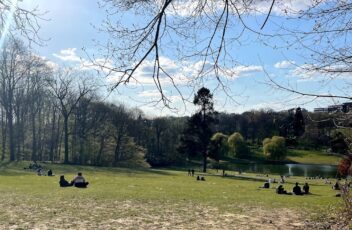The fast-paced urbanization and disconnection of people from nature and the current series of lockdowns, contribute to an increasing burden of mental health disease in cities. Researchers have estimated that it is 39% more likely to develop depression when living in urbanized areas as compared to rural regions [source]. Other mental illnesses and neurodegenerative disorders such as anxiety, substance abuse, and dementia are also taking a large toll on the lives of urban dwellers.
The environmental determinants of this phenomenon are most obviously the noise, pollution, and abundance of distracting elements in the space, which keep attention at the mode of alertness. In addition to these factors, there are certain visual constraints and limited contact with nature, which contribute a substantial psychological burden to those living in urbanized spaces.
There are a lot of unanswered questions about the specific mechanisms of why this happens and, more importantly, how to design our cities to not only prevent mental illness but also improve our wellbeing. Several research teams around the world, including our scientists and landscape architects at NeuroLandscape, have been investigating the influence of exposure to different living environments on brain activity.
From multiple neuroscience experiments and cross-sectional analyses, it seems that the quantity of green cover in the city is not enough to trigger a beneficial mental health response. The proximity and accessibility of green spaces in relation to residency is a very important start point to mitigate the mental health decline but does not consistently determine better mental health outcomes. Like in many other aspects of life quality outperforms quantity.
In the era of the color green, urban planners, landscape architects and city managers, lend me your ears! —Do not green cities mindlessly.
There are certain types and components of urban green spaces which can reduce stress levels, restore our attention, regulate emotions, bring back positive motivation, and improve cognitive functioning by just passively experiencing them [our library on that topic]. They include open and panoramic landscape compositions, which allow far-away views into the landscape, but also enclosed pocket gardens inviting for calm relaxation and solitary contemplation. The visibility of natural asymmetry, undulating landforms and a diversified skyline also count towards that restorative effect. Among many other salutogenic landscape design strategies, seasonally changing, lush vegetation, and the presence of strong symbolic features, such as water, play an important role too.
In the endeavor to create liveable cities we have been through several stages, starting with the consideration of functionality and logistics, which was followed by improvements to sanitation, safety, equity, greening and sustainability, and finally led up to a focus on the mental health. The research to support this latest stage is ongoing. However, it is becoming clear that mentally healthy cities rely on the quality rather than quantity of green and natural elements.
With that in mind, nature is not to be visited (like visiting a gallery or animal park) but rather, a backdrop to our daily events and activities. For this vision to be feasible and effective, evidence-based landscape design is indispensable.
President and Founder of NeuroLandscape. Ph.D. in Landscape Architecture and Urban Ecology, in her research she explores the relationship between the different features of the natural and built environment’s influence on human health and well-being. She has successfully incorporated neuroscience tools to investigate the changes in brainwave oscillation in people exposed to different types of scenery. She has introduced and operationalized the term contemplative landscape and proposed a quantitative assessment scale – a Contemplative Landscapes Model (CLM) – to identify most beneficial landscapes for mental health in terms of passive exposure. She is an author of “Neuroscience for Designing Green Spaces: Contemplative Landscapes”, Editor-in-Chief of the Journal of Urban Design and Mental Health. She is continuing her research on therapeutic landscapes under two ongoing Horizon Europe projects: GreenME and GreenInCities.



